Farmers, extension professionals, the private sector, and other stakeholders are uniquely impacted by agricultural innovation. The following are accounts of their experiences in implementing mechanized seeders in the field, applying IPM, and lessons learned along the pathway toward sustainability.

.
In Cambodia, the majority of farmers grow rice through the traditional method of hand broadcasting seed. This method, however, often requires exorbitant amounts of labor, seed, fertilizer, and chemical pesticides, which can be costly for already resource-poor communities. Additionally, dense plots created by manual broadcasting are more prone to pests and diseases.
Sustainable innovations have the potential to render crop production in Cambodia more efficient and environmentally friendly. In fact, it’s at the core of the partnership between the Feed the Future Innovation Lab for Integrated Pest Management (IPM IL) and the International Rice Research Institute (IRRI). The collaboration works to increase access to sustainable, time-saving, and yield-increasing farming technologies that will help farmers across the country grow rice in greater quantities and with higher quality.
The IPM IL-IRRI collaboration is how some farmers and extension professionals in Cambodia came to know about mechanized rice seeders. Attached to a tractor, the device uses air pressure to shoot rice seeds directly into the soil and in uniform rows. The use of a mechanized seeder for sowing rice seeds reduces inputs and labor.

.
The Eli Rice Seeder, in particular, which IPM IL and IRRI introduced at trade fairs in Cambodia, is a mechanized seeder developed by Agri-Smart and its partner Brooklyn Bridge to Cambodia. On average, farmers’ use of the Eli Rice Seeder saves USD 250.00 per hectare (ha), increases yields by 20%, and reduces planting time from 40 labor-days to only 2 hours. Mechanized seeders are also compatible with integrated pest management (IPM) solutions.
Farmers, extension professionals, the private sector, and other stakeholders are uniquely impacted by agricultural innovation. The following are accounts of their experiences in implementing mechanized seeders in the field, applying IPM, and lessons learned along the pathway toward sustainability.
Prak Sim, farmer and service provider
Mr. Sim owns four hectares of land in the Muong District of Battambang and heads the Kea Agricultural Cooperative in Tanak Village, Kea Commune. He owns an Eli Rice Seeder, which he uses for wet conditions, and a Thai-KID Seeder, which is a mechanized seeder he uses for dry conditions.
“One of the greatest constraints for farmers is that they are incredibly dependent on rainfall if you hand-broadcast seed,” Mr. Sim said. “Farmers use large amounts of seed with little capital to afford it.”
Mr. Sim offers mechanical seeding service to neighboring farmers’ fields for USD 15.00/ha. Since he began seeding farmers’ fields, he has observed a decrease in input purchases and application, including a reduction in seeds from nearly 200 kilograms (kg)/ha to only 70kg/ha.
“It was worth the investment [to purchase the machine] because of the high yields and easy crop care,” Mr. Sim said.
With row seeding, weed management is easier. Additionally, Mr. Sim said that using the rice seeder has catalyzed his own motivation to innovate. His goal is to adapt the Eli Rice Seeder to be used in dryer conditions. He also hopes to add spraying capabilities to the tractor as well.

.
Kun Sa-Em, farmer and head of Baphnom Agricultural Cooperative
Mr. Sa-Em manages a rice-based cooperative and provides seeding services for other farmers. The cooperative produces seeds and sells paddy rice, but also has an internal credit provision system for inputs and machinery services provided to its members. Through this program, Mr. Sa-Em set up a demonstration plot for rice technologies like mechanized seeding.
He said that farmers visiting the demonstration plot were interested in the Eli Rice Seeder predominantly for its efficiency. In one day, Mr. Sa-Em can seed up to five hectares of farmland. Although hand-broadcasting is less expensive–-USD 10.00/ha for hand-broadcasting versus USD 12.50/ha for mechanized seeding–-Mr. Sa-Em believes the benefits outweigh the extra cost.
“Limited labor is quite challenging,” Mr. Sa-Em said. “For hand broadcasting, much seed is used (150kg/ha). With the Eli Rice Seeder, less than 100kg/ha of seed is needed. It also generates more vigorous seedlings.”
He wants to adapt the Eli Rice Seeder for even greater efficiency. He is currently brainstorming the design of different wheels for the machine that do not require air so that they do not compact the soil. Additionally, Mr. Sa-Em wants to improve the ease of the machine’s seed dispersal calibration as the machine often shoots more seeds from the center of the tractor than from the ends.
Chhoeut Sarith, farmer
Mr. Sarith is a farmer in Omal Commune in Battambang where he owns a 15-ha land and a Thai KID Seeder for family use.
Mr. Sarith remarked that, with climate change, droughts remain a major constraint for farmers, which leads to an unstable market price of paddy.
“The Thai-KID Seeder produces yields comparable to hand broadcasting,” he said about the guaranteed quality a rice seeder can bring. “While using less seed, it also makes it easier to hand weed and use chemical spray.”
Thy, farmer and head of Kampong Preang Cooperative
Mr. Thy owns a 15-ha land in the Sanke District of Battambang and heads the Kampong Preang Agricultural Cooperative. He purchased an Eli Rice Seeder and a Thai-KID Seeder after Agri-Smart provided training on its operation. He equipped both machines with a sprayer for the application of pesticides and biopesticides.
“[With the use of a mechanized seeder] you can plant seeds at night and day time,” he said. “This is important for timely planting of seeds compared to hand broadcasting.”
Mr. Thy observed increased yields using the seeder although he still hopes to improve the machine’s planting time as he noticed that the Thai-KID Seeder often plants too fast.
By providing the service of seeding other farmers’ fields, he earns additional income.
“It is very good to make this investment [in the seeder],” he said. “It can help us earn more money aside from our other incomes. The profit for the first year of providing Thai-KID seeder to our members and other seed producers is about USD 7,000.”
One of the neighboring farmers, whose field Mr. Thy cultivates, said that one of the constraints of mechanization is lack of trust.
Farmers want to wait to observe results before adopting new technology, according to Mr. Thy’s neighbor.

.
Choun Saban, extension officer
Mr. Saban is an extension officer at the Provincial Department of Agriculture, Forestry, and Fisheries (PDAFF) and an IPM focal point person in the Prey Veng Province. He first learned about the Eli Rice Seeder by observing demonstration plots established by the IPM IL-IRRI project.
Despite the benefits of harvesting crops that garner higher profits for being grown with limited use of chemical pesticides, the fairly low adoption rate of IPM in developing countries could be attributed to the additional tasks that IPM sometimes requires such as monitoring pest populations or record-keeping.
Mr. Saban said that farmer perception has a major impact on IPM adoption in Cambodia.
“Farmers assume that IPM would require more labor,” he said. “As a result, some farmers do not want to use seeders or IPM packages.”
IPM packages are a mainstay of IPM implementation. “Packages” are combinations of IPM solutions (for example, application of biopesticides, use of pheromone traps, and crop rotation) that farmers choose to solve crop problems.
Mr. Saban suggested that IPM certification could formalize and incentivize farmers’ use of IPM technologies and encourage the implementation of new practices.
“Farmers sell their produce to markets regardless of the management practices they use so they don’t see the need to use IPM on their farms,” he said. “However, if there is contract farming that requires farmers to use IPM for higher prices, farmers would follow IPM.”
The IPM IL-IRRI partnership has distributed an IPM publication in the Khmer language that helps farmers achieve certification for sustainably produced rice.
Mr. Saban added that continued site visits to demonstration plots and farmer field days help farmers observe the positive outcomes of IPM practices.

.
Chhun Sokunroth, extension officer
Mr. Sokunroth is an IPM focal point and extension officer at PDAFF in Battambang. He helps farmers establish rice demonstration fields using IPM practices, including the implementation of different rice seeders, the application of biopesticides, and the rodent trap barrier system, which ensnares rodent species that damage crops.
Mr. Sokunroth’s first exposure to the Eli Rice Seeder was through the IPM IL-IRRI project. He confirmed that growing less-dense fields produces a chain reaction of benefits.
“The Eli Rice Seeder helps reduce the incidence of pests and diseases because there is more space in the rice field with no competition for sunlight and does not provide a suitable environment for insect pests, fungus, or other pathogens,” he said. “Weed management practices can also be done easily. It benefits farmers to reduce the seed amounts, labor, and energy while increasing their yield and gaining more profit. Other benefits include less fertilizer use and low dependency on pesticides.”
When applied in excess, fertilizer can make plants more susceptible to pests and diseases. Excessive nitrogen application can also reduce stem strength.
Bunika San, private sector representative
Mr. San is a horticulturalist by training. The former country director of Agri-Smart, Mr. San continues to promote the use of rice seeders and other products developed by the company and its collaborators in his new role as a private sector representative.
One of the benefits of agricultural machinery is how rapidly machines can be altered to best serve farmers. Mr. San said that five different versions of the Eli Rice Seeder have been developed since 2015, with each model an improvement over the earlier models.
The first version, for example, required three people to carry the machine into the rice fields and another person to carry it deep into the mud. The second model required less labor but the machine worked mostly on sandy soil. The third and fourth models included the addition of a two-wheel tractor hooked onto the machine, decreasing the heavy lifting for farmers.
Finally, the fifth and current version includes a metering device that performs in all types of soils–muddy, sandy, or dry–and is capable of planting a variety of seeds in addition to rice, including green bean and soybean seeds.
“It is important to continue developing the Eli Rice Seeder for farmers,” said Mr. San. “They can grow rice seed with spacing from 15-25 centimeters and can plant rice seed fast, usually 1.5 hours/ha.”
The latest version requires only 1-2 people to operate and uses anywhere from 40kg to 100kg of rice seed/ha, according to Mr. San. Most importantly, the machine generally reduces burdens on farmers and their farms across the spectrum, including overall purchasing of inputs, he added.
Mr. San noted that the Eli Rice Seeder is most popular in Battambang and Takeo, where he widely advertised the machine.
“The machine reduces the cost and the use of rice seeds, fertilizers, chemical fungicides, insecticides, and herbicides, which help protects our environment from pollution,” he said.
Varied experiences, shared goals for sustainability
Manufacturers, farmers, and other stakeholders look for tools that can help with sustainable rice production. A wide range of experiences with seeders and the lessons learned from their implementation will continue to help shape the pathway toward improved seed rates, decreased pest infestation, and increased food security.
Packaged with IPM, mechanical rice seeders show potential for increasing the benefits of sustainable practices. While many innovations are ongoing, agricultural mechanization progress shows promise for addressing the important needs of rice stakeholders throughout Cambodia and beyond.
The IPM IL is housed at Virginia Tech’s Center for International Research, Education, and Development and is funded by the U.S Agency for International Development.
For more information please contact the authors:
Ms. Sara Hendery, communications coordinator, IPM IL, Virginia Tech
Dr. Rica Joy Flor, scientist, IRRI Cambodia Office, Phnom Penh, Cambodia.


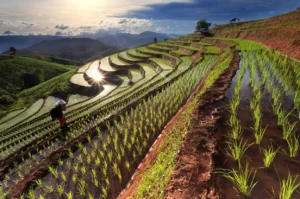
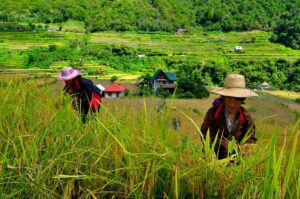
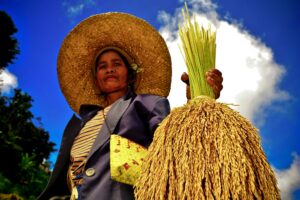
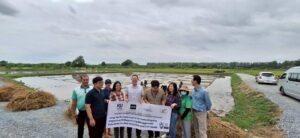
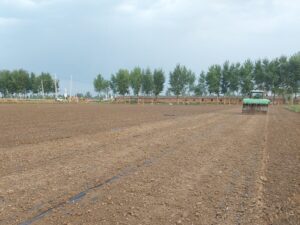
Please can I get more information on Eli seeder.
Thanks